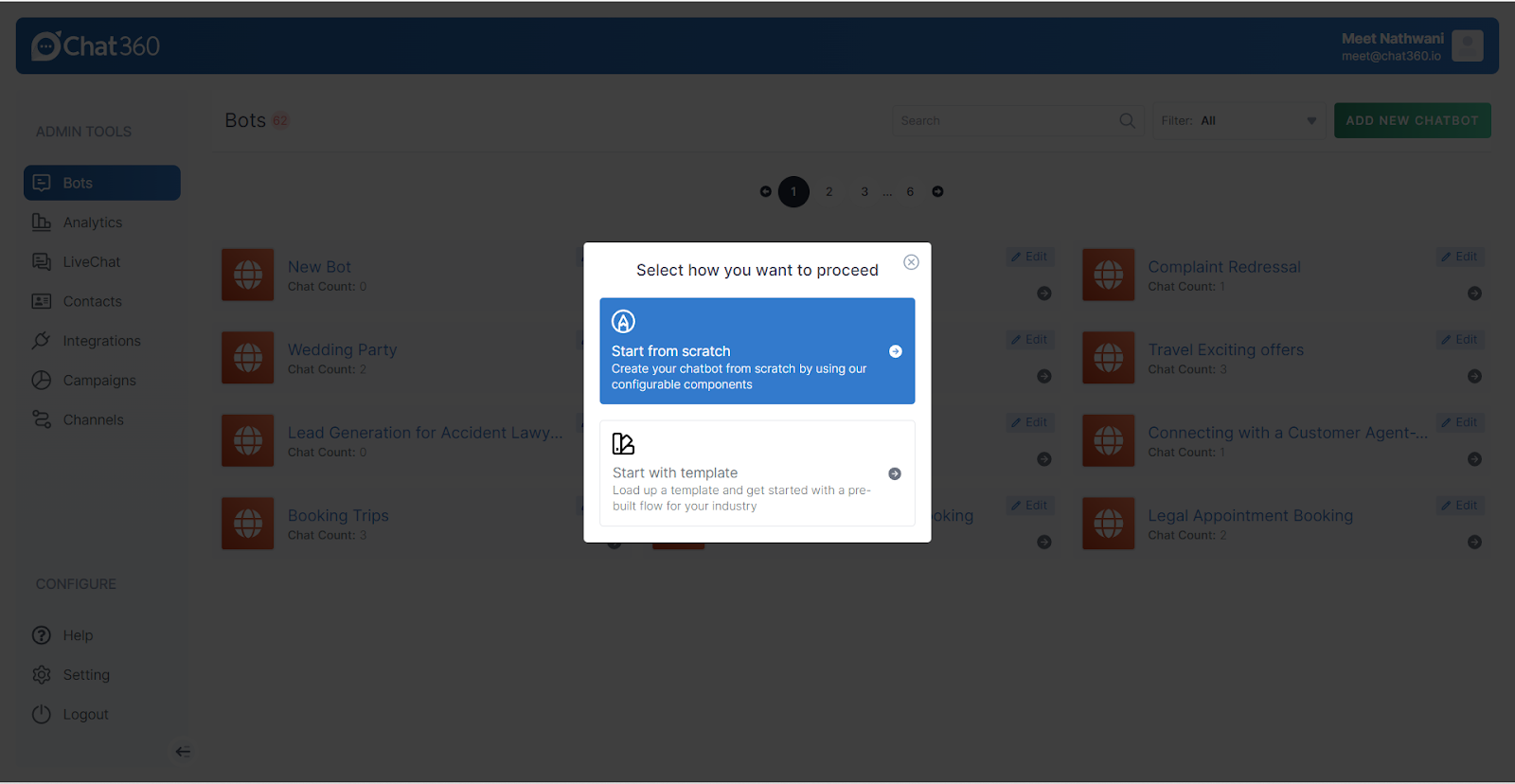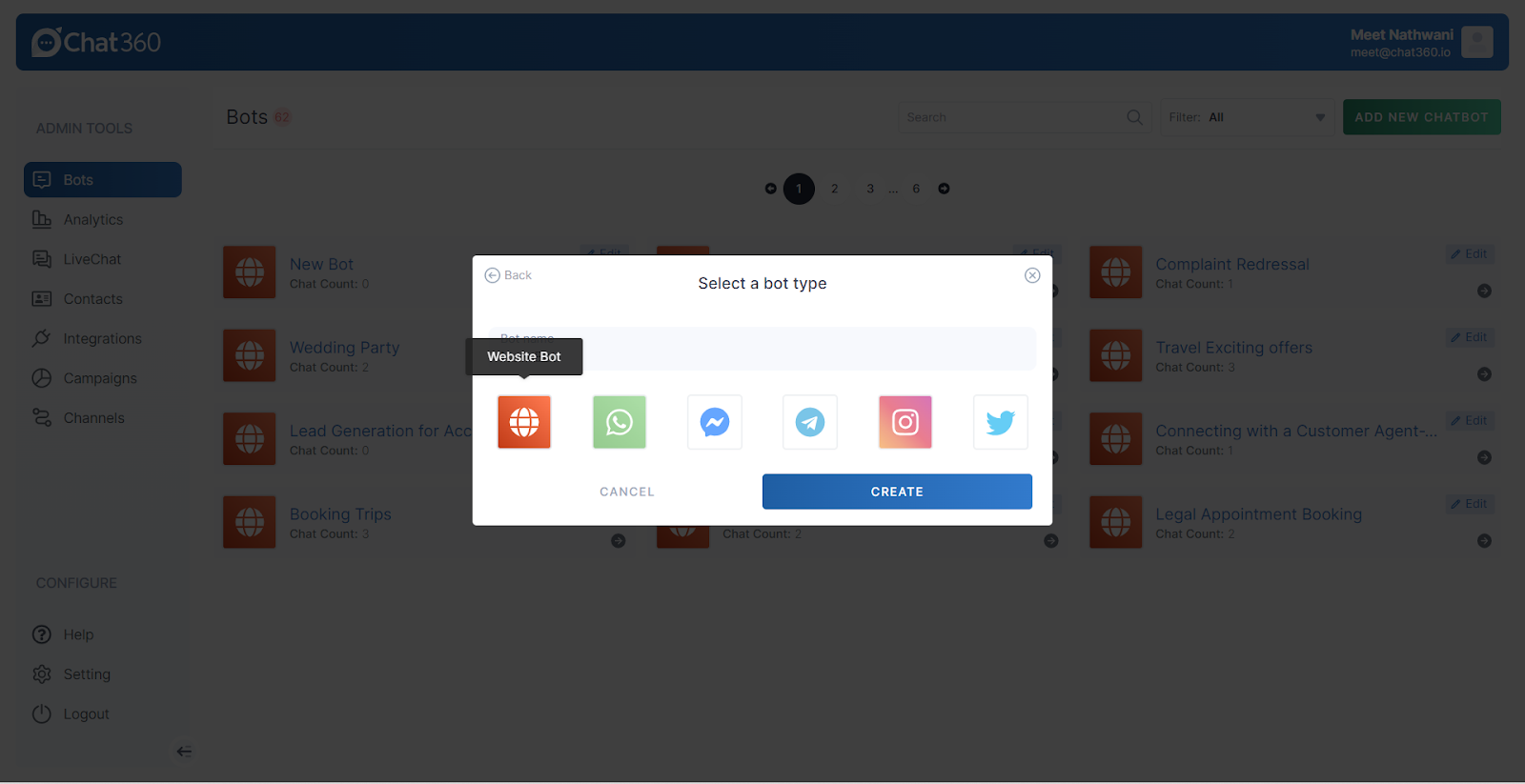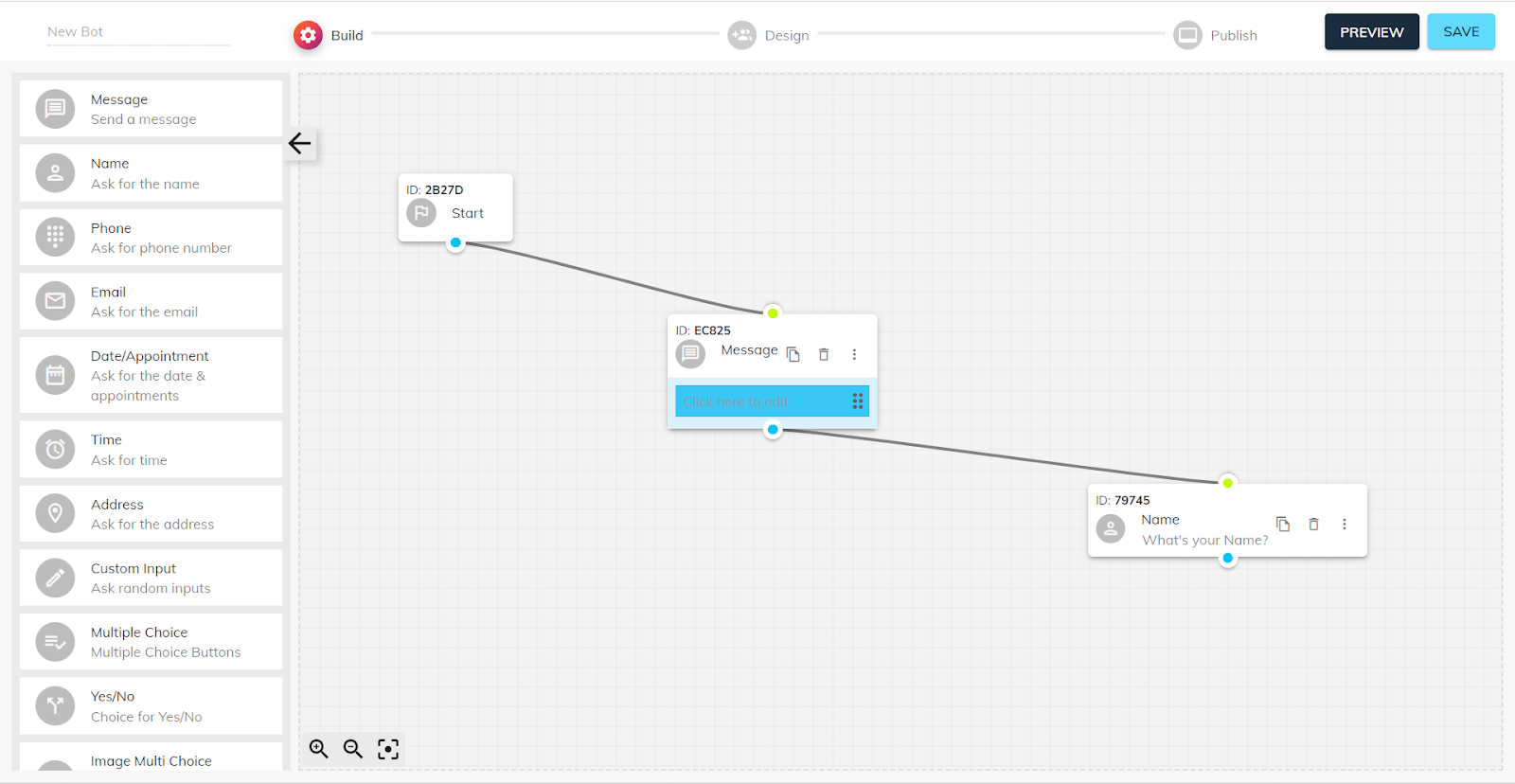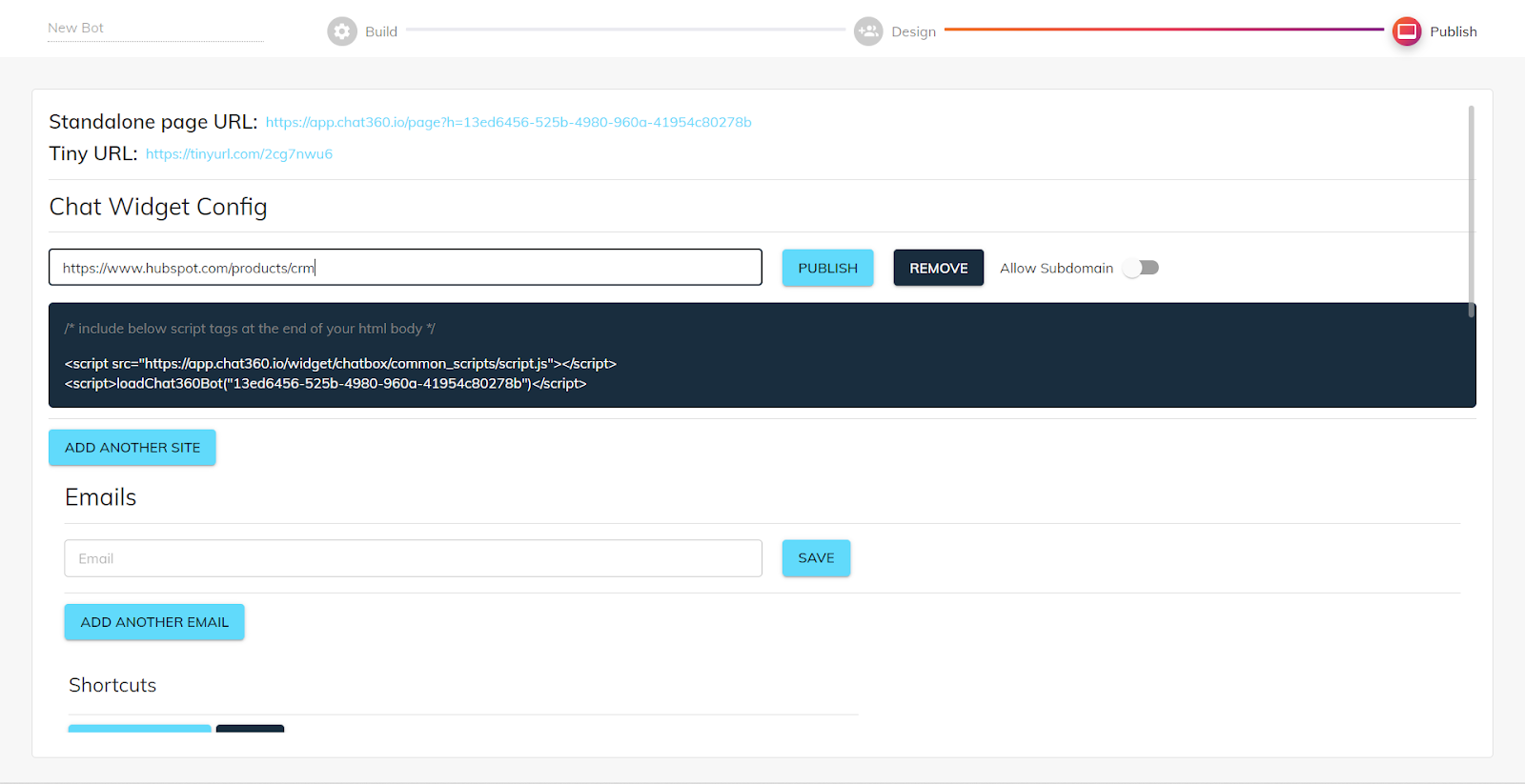In today’s fast-paced world, meeting customer demands has become more challenging than ever. With constantly evolving marketing trends and increasing competition, businesses need to stay ahead of the curve to remain relevant. To achieve this, it is crucial to leverage technological advancements and integrate them into your operations. Website Chatbots are a prime example of a technology that can give your business an edge by providing exceptional customer service and handling inquiries seamlessly on your website and other platforms. By embracing chatbots for website, businesses can not only improve their efficiency but also provide a personalized experience for their customers, setting them apart from the competition.
After learning what and how website chatbot work, in this article, we will discuss all about how to create a website chatbot for your business.
Things to look for while selecting a website chatbot builder
Before you build a chatbot, you need to determine the objectives you are making it for and then select the chatbot builder. Choosing the right chatbot builder is essential since it will determine the outlook of your chatbot, how it functions, and if it fulfills your requirements. All and all, a chatbot builder should have the following features.
1. Freedom to customize
You need this feature in the chatbot builder because highly customized website chatbots can be taught and trained per the requirements of your business and customers. Furthermore, it can adapt to the kind of conversations best suited to your customers. Bots can collect customer data and pick up their behavioral patterns through AI, making the entire conversation with the customer more accessible and personalized.
You can customize your bots at Chat360. These bots are neither dull/monotonous nor too prevalent. Discover what an impeccable job Chat360 web bots can do for your customer interaction. Chat360 provides you a complete guide to designing your bot with freedom and utilize it with the features essential for your business.
2. Easy to deploy on all channels
The social media presence of your business is significant, especially when a user spends an average of 2 hours and 27 minutes on social media. If your customers spend so much time on social media every single day, then your presence there becomes a necessity.
Therefore, along with the website, the website chatbot builder should enable you to deploy the chatbot on other platforms. Chat360 allows omnichannel deployment and helps you customize the chatbots as per the requirement of the media.
3. Integration with other applications
Integrating your chatbot with third-party applications will help you track your ROI, keep an eye on the analytics, and extract necessary data to monitor customer trends.
4. Multilingual conversations
Out of all the things, linguistic boundaries should not be a hurdle stopping your business from growing. If you want to expand your business globally or in a particular country like India, your chatbot will encounter customers who prefer chatting in their dialects. These dialects can sometimes get difficult for bots to understand as they were not trained on these before. That is why multilingual engagement becomes crucial for any business.
Chat360 removes all these boundaries for you and lets you build a chatbot that can tackle conversations in different languages making your customers feel comfortable.
5. Privacy & secure conversations
Chat360 thrives on the ethic of privacy and security. Several data breaches happen now and then, which is why Chat360 is a chatbot builder that helps you design a secure website chatbot.
You can ensure your customers that there will be no data theft and that their information is secure with your business. Transparency is what builds strong business relationships.
How To Build A Website Chatbot Using Chat360
Set Specific Goals
- End-to-end engagement with customers: Whenever a customer visits your website, the chatbot will solve their queries instantly, and they can be converted into a lead in no time.
- Capturing more leads before visitors bounce off the website: Visitors often bounce off of a website when they cannot find what they are looking for. This can be frustrating for both, the visitor and the business.. The website chatbot will be able to assist them, eventually converting them into a lead.
- Keep your recurring customers engaged: Keeping recurring customers engaged is essential to making them loyal to your brand. Chatbot helps you store their information and then use it later for personalized interaction.
Steps to build your website chatbot with Chat360
Chat360 has now made designing chatbots as easy as sipping tea!You can get started and have your chatbot ready and working within an hour.
Step 1: Sign up/log in
Step 2: Choose either start from scratch or template.

Step 3: Choose the option to build a website chatbot.

Step 4: Start creating your bot by dragging and linking the options from the left side panel window. Customize the chat flow as per your business’s needs.

Keep going and create your bot.
Step 5: Design your user interface on the design option.

Once this is done, your bot is ready to be published. Keep the following things in mind while designing your bot.
Customizing Website Chatbots For Your Specific Brand Tone
Consider this example: your interaction with the chatbot on an e-commerce website is highly different from the one you have on a bank website. Why? After all, both are chatbots, but there is still an extra flair in conversation, and the tone is also different. The type of questions asked in both the Line of Business is different.
This difference is because of the objective the bot is serving. Customizing your chatbots as per the customer’s needs is essential so that the customer does not face any communication gap while interacting with the chatbot.
Read more about: Top Website Chatbot Examples
Here is how you can customize your chatbot for your website as per your brand’s tone:
Understand the user
- Who is the end-user?
- What are they looking for when reaching out to your business?
- What is the time used by customers to interact?
- Find answers to these questions to build your brand tone.
Develop a unique identity for your website chatbot
The chatbot will be the first interaction between your customer and your business. This interaction must be wise, well thought out, and informative for the customer. To make that happen, your bot must have an identity that will add a hint of human touch to the interaction.
Giving your bot a name or photo will make the customer feel more comfortable interacting with it. Do not forget- the more distinctive your bot, the more unforgettable it is.
Defining the voice tone
After you have found answers to the questions mentioned above and given your bot an identity, the next step is to find the time in which the bot will converse. That chatbot will represent the brand, so it needs to follow the tonality of your business.
For example, if you want an informal tone, your bot can start the conversation like- “Hey there! I am XYZ, I have been great. How have you been?”
If you want the time to be more formal and your customers prefer a to-the-point conversation and do not want to indulge in small talk, then your bot can start the interaction like- “Hello, I am XYZ. I will be assisting you today. How can I help you?” (You can add a drop-down menu from which the customer can choose the topic for the conversation.)
Now that your bot is fluent with your tone, the next step is to add elements that will enhance your chatbot.
Different Design Elements To Enhance Your Website Bot
Definite purpose
It is an exciting task to create a chatbot. But before you begin with it, define the purpose of your chatbot. Ask how this not will be helping your customers and what role it will be playing in assisting them. Do not forget that a chatbot is not a replacement for any services you are already providing to your customers. It is a way to enhance your customer interaction and improve manifolds.
For instance, if you want to shorten your sales cycle, design your chatbot accordingly. If you want to design a chatbot for customer support, the design would be completely different from the one mentioned above.
Personality
Giving a persona to your chatbot is crucial as it is built to represent your brand. The personality of your chatbot and its characteristics should be in sync with the customer’s goal that leads them to your business.
To define the personality of your bot, consider the following aspects:
- Name
- Gender
- Language
- Location
- Primary objectives and actions
Tone and attitude
As mentioned above, the tone of the chatbot will determine how the interaction builds up with your customer. Therefore, choose the set of words and expressions carefully; your bot will use that.
The tone of the conversation could be anything from sarcastic to formal but make sure it is customer-oriented and tackles the more significant part of your customer base.
UI design
User interface design for chatbots is essential for visual appeal. Focus on building a visual appeal that syncs with your brand. Use brand logo colors and texts to make the interaction richer.
Manage Website Chatbot Flow Triggers
Chatbot flow triggers are the chat interactions often triggered by customer actions. For instance, when you are on a website reading their blog or surfing their product page, a pop-up asks you, “How can I assist you today.” That is the chatbot flow trigger. You can have several triggers as per the user intent. One such example is the cart abandonment trigger. You can remind the customer that they should proceed to buy the product in their cart.
Creating a Smooth Conversational Flow for your website chatbot
A chatbot flow is a formation that defines how the conversation will take place with a chatbot considering the questions the chatbot will ask and the probable replies it will receive from the customers. A chatbot flow is the series of interactions that customer actions or responses can trigger.
Questions to answer before creating a flow.
What business problems are you trying to solve?
Find the end goal. Find the purpose for which you are installing a chatbot onto your website. Design the chatbot flow keeping in mind the business problem and the solution the bot will provide.
What is your use case?
Define who will be the end-user. A customer coming to find more information about a product is a lead and a customer coming to give feedback is the one you need to retain. The chatbot flow for both of them would be poles apart. Defining your use case clearly without leaving any gaps that might impact the customer interaction negatively.
Who is your bot?
You don’t want your customers to interact with a weak bot. Give a personality to your bot to make the conversations more exciting and fun. Give your bot a story and a name, and bring them into existence. Add vibrancy to your bot by giving them a persona. (Every time a customer thinks of your brand, they should be reminded of your bot as well)
How to create a great conversation flow
To create a conversational flow, you need to keep the replies short and crisp. Chatbots are dull and often annoy the customer. Keep your answers quick and precise. Keep the elements of a conversation in mind, and design your scripts.
Elements of a conversation of website chatbot
- Greetings- Hi, hello, welcome, and so on.
- Asking- to extract information or purpose of the customer for visiting.
- Information exchange- giving information or the customer or retrieving it from them to keep the conversation meaningful.
- Checking- repeating the information for the customer’s clarity.
- Apologizing- understanding the shortcomings of a chatbot and offering a bridge to an alternate conversation.
- Error- when the bot fails to understand the customer input.
- Recommendation- giving suggestions to the user.
- Conclusion- ending the conversation without leaving any gaps (can add a thank you or bye).
- Visual elements- like pictures, videos, GIFs, etc. to engage the customer.
- Configure synonyms for your bot
Tackling The Fallback Scenario
It must be understood that a chatbot will never come on par with human intelligence. It is an excellent gift from technology, but even science has its shortcomings; thus fallback scenarios should be envisioned and planned. However, how your chatbot handles the fallback scenario makes all the difference. Here is how to smartly tackle them:
Acknowledge
Acknowledging that the chatbot could not comprehend the input, it is better to come clean instead of beating around the bush. The chatbot can say- “Sorry, I did not understand that.”
Give an alternative
When the fallback happens, it becomes even more critical to keep the conversation going or bring it back on track. In one such scenario, after apologizing, the bot can give the options menu to the customer to select from and then carry on the conversation again.
Friendly approach
The tone of your chatbot should be similar throughout the conversation, even during a fallback scenario. If a chatbot cannot understand the customer query, it can simply say, “Sorry, I haven’t got that far. I am still learning, but I can help you with (a solution for a common problem posed by the customers).”
Provide a way out
It can be frustrating for a customer to get a fallback reply after trying many times constantly. Before they reach the infuriating point, give them a way out. A way out could be anything-
- Handing over the conversation to a human.
- Taking users’ information and then raising a ticket for the issue they face.
- Provide alternate contact information to the user so they can connect with a human on a one-to-one base.
- Offering them to end the conversation.
Testing Your Website Chatbot To Measure Efficiency
Bots have many functional integrations and evolve as per the market demand and customer requirements. It becomes essential to test their efficiency due to the following reasons.
- To stay updated as per the AI-based developments.
- To make sure the efficiency is top-class to get maximum ROI.
- To ensure that customers are getting good quality services.
- To adapt to the growing needs and customer demands.
Features to check while testing the efficiency of Website Chatbot
Conversation flow
The fundamental aim of any chatbot is to make intelligent conversations happen. It must be tested if the bot can understand human queries and, if not, how it is handling a fallback scenario.
Speed and accuracy
Customers expect immediate responses when they are interacting with a chatbot. If the chatbot takes 2-3 minutes to answer one customer question, then there is no point in the entire technology. Checking how fast the bot is replying and how accurate the response is essential.
Confusion handling
Human texts can contain a lot of typos, sentiments, sometimes images, and occasionally hard-to-understand words. The chatbot should be able to handle any such text amicably and be able to politely convey that it did not understand and would request the customer to give their input again.
Non-Coding Vs. Code-Based Framework- Which is Best?
In today’s scenario, the best service is the one you get without much hassle. No-coding chatbots are that service, and Chat360 provides you with just that!
Benefits of no-coding website chatbot
- Hassle-free creation and accelerated process. (You can get yours within an hour from Chat360)
- Intelligent automation with minimal human intervention.
- Applicable to several use cases.
- Cost-friendly
- Easy to use.
Steps To Add a Website Chatbot
Step 1: Once you create your website bot, it is time to take it live. To do that, click on the publish button.
Step 2: Add the website URL and fill all the other fields.

Step 3: Click the publish button to get a code.
Step 4: Copy and paste the code at the end of the HTML body of your website.

Tada! Your bot will now be active on your website.
Developing a website chatbot with Chat360 is a cakewalk. Get your website chatbot now by signing up!
To sum it up
In conclusion, creating a website chatbot is a valuable way to enhance user experience and engagement on your website. By following the steps outlined above, you can create a chatbot for your website that provides visitors with helpful information and assistance while also boosting your business’s efficiency and productivity. Remember to consider the purpose of your chatbot, choose the right platform, design a conversational flow, and integrate it seamlessly into your website. With a well-designed web bot, you can provide your customers with an improved user experience and set your business apart in today’s digital marketplace.